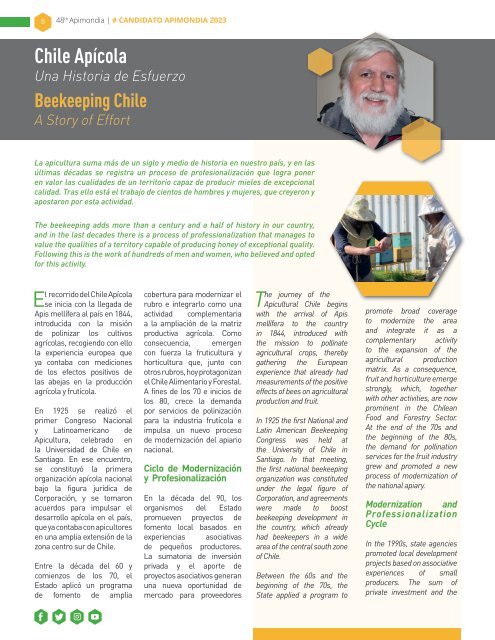Revista Apimondia En Chile
Create successful ePaper yourself
Turn your PDF publications into a flip-book with our unique Google optimized e-Paper software.
8 48 th <strong>Apimondia</strong> | # CANDIDATO APIMONDIA 2023<br />
<strong>Chile</strong> Apícola<br />
Una Historia de Esfuerzo<br />
Beekeeping <strong>Chile</strong><br />
A Story of Effort<br />
La apicultura suma más de un siglo y medio de historia en nuestro país, y en las<br />
últimas décadas se registra un proceso de profesionalización que logra poner<br />
en valor las cualidades de un territorio capaz de producir mieles de excepcional<br />
calidad. Tras ello está el trabajo de cientos de hombres y mujeres, que creyeron y<br />
apostaron por esta actividad.<br />
The beekeeping adds more than a century and a half of history in our country,<br />
and in the last decades there is a process of professionalization that manages to<br />
value the qualities of a territory capable of producing honey of exceptional quality.<br />
Following this is the work of hundreds of men and women, who believed and opted<br />
for this activity.<br />
El recorrido del <strong>Chile</strong> Apícola<br />
se inicia con la llegada de<br />
Apis mellífera al país en 1844,<br />
introducida con la misión<br />
de polinizar los cultivos<br />
agrícolas, recogiendo con ello<br />
la experiencia europea que<br />
ya contaba con mediciones<br />
de los efectos positivos de<br />
las abejas en la producción<br />
agrícola y frutícola.<br />
<strong>En</strong> 1925 se realizó el<br />
primer Congreso Nacional<br />
y Latinoamericano de<br />
Apicultura, celebrado en<br />
la Universidad de <strong>Chile</strong> en<br />
Santiago. <strong>En</strong> ese encuentro,<br />
se constituyó la primera<br />
organización apícola nacional<br />
bajo la figura jurídica de<br />
Corporación, y se tomaron<br />
acuerdos para impulsar el<br />
desarrollo apícola en el país,<br />
que ya contaba con apicultores<br />
en una amplia extensión de la<br />
zona centro sur de <strong>Chile</strong>.<br />
<strong>En</strong>tre la década del 60 y<br />
comienzos de los 70, el<br />
Estado aplicó un programa<br />
de fomento de amplia<br />
cobertura para modernizar el<br />
rubro e integrarlo como una<br />
actividad complementaria<br />
a la ampliación de la matriz<br />
productiva agrícola. Como<br />
consecuencia, emergen<br />
con fuerza la fruticultura y<br />
horticultura que, junto con<br />
otros rubros, hoy protagonizan<br />
el <strong>Chile</strong> Alimentario y Forestal.<br />
A fines de los 70 e inicios de<br />
los 80, crece la demanda<br />
por servicios de polinización<br />
para la industria frutícola e<br />
impulsa un nuevo proceso<br />
de modernización del apiario<br />
nacional.<br />
Ciclo de Modernización<br />
y Profesionalización<br />
<strong>En</strong> la década del 90, los<br />
organismos del Estado<br />
promueven proyectos de<br />
fomento local basados en<br />
experiencias asociativas<br />
de pequeños productores.<br />
La sumatoria de inversión<br />
privada y el aporte de<br />
proyectos asociativos generan<br />
una nueva oportunidad de<br />
mercado para proveedores<br />
The journey of the<br />
Apicultural <strong>Chile</strong> begins<br />
with the arrival of Apis<br />
mellífera to the country<br />
in 1844, introduced with<br />
the mission to pollinate<br />
agricultural crops, thereby<br />
gathering the European<br />
experience that already had<br />
measurements of the positive<br />
effects of bees on agricultural<br />
production and fruit.<br />
In 1925 the first National and<br />
Latin American Beekeeping<br />
Congress was held at<br />
the University of <strong>Chile</strong> in<br />
Santiago. In that meeting,<br />
the first national beekeeping<br />
organization was constituted<br />
under the legal figure of<br />
Corporation, and agreements<br />
were made to boost<br />
beekeeping development in<br />
the country, which already<br />
had beekeepers in a wide<br />
area of the central south zone<br />
of <strong>Chile</strong>.<br />
Between the 60s and the<br />
beginning of the 70s, the<br />
State applied a program to<br />
promote broad coverage<br />
to modernize the area<br />
and integrate it as a<br />
complementary activity<br />
to the expansion of the<br />
agricultural production<br />
matrix. As a consequence,<br />
fruit and horticulture emerge<br />
strongly, which, together<br />
with other activities, are now<br />
prominent in the <strong>Chile</strong>an<br />
Food and Forestry Sector.<br />
At the end of the 70s and<br />
the beginning of the 80s,<br />
the demand for pollination<br />
services for the fruit industry<br />
grew and promoted a new<br />
process of modernization of<br />
the national apiary.<br />
Modernization and<br />
Professionalization<br />
Cycle<br />
In the 1990s, state agencies<br />
promoted local development<br />
projects based on associative<br />
experiences of small<br />
producers. The sum of<br />
private investment and the


